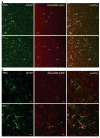Astrocytes modulate distribution and neuronal signaling of leptin in the hypothalamus of obese A vy mice
- PMID: 21086065
- PMCID: PMC3521588
- DOI: 10.1007/s12031-010-9470-6
Astrocytes modulate distribution and neuronal signaling of leptin in the hypothalamus of obese A vy mice
Abstract
We tested the hypothesis that astrocytic activity modulates neuronal uptake and signaling of leptin in the adult-onset obese agouti viable yellow (A vy) mouse. In the immunohistochemical study, A vy mice were pretreated with the astrocyte metabolic inhibitor fluorocitrate or phosphate-buffered saline (PBS) vehicle intracerebroventricularly (icv) followed 1 h later by Alexa568-leptin. Confocal microscopy showed that fluorocitrate pretreatment reduced astrocytic uptake of Alexa568-leptin 30 min after icv while increasing neuronal uptake in the arcuate nucleus and dorsomedial hypothalamus. Fluorocitrate also induced mild astrogliosis and moderately increased pSTAT3 immunopositive neurons in response to Alexa568-leptin in the dorsomedial hypothalamus. In the Western blotting study, A vy mice were pretreated with either PBS or fluorocitrate, and received PBS or leptin 1 h later followed by determination of pSTAT3 and GFAP expression an additional 30 min afterward. The results show that fluorocitrate induced a mild pSTAT3 activation but attenuated leptin-induced pSTAT3 activation and decreased GFAP expression independently of leptin treatment. We conclude that inhibition of astrocytic activity resulted in enhanced neuronal leptin uptake and signaling. This suggests opposite roles of astrocytes and neurons in leptin's actions in the A vy mouse with adult-onset obesity.
Conflict of interest statement
Figures




Similar articles
-
Role of Astrocytes in Leptin Signaling.J Mol Neurosci. 2015 Aug;56(4):829-839. doi: 10.1007/s12031-015-0518-5. Epub 2015 Feb 17. J Mol Neurosci. 2015. PMID: 25687329 Free PMC article.
-
Obesity induces functional astrocytic leptin receptors in hypothalamus.Brain. 2009 Apr;132(Pt 4):889-902. doi: 10.1093/brain/awp029. Epub 2009 Mar 17. Brain. 2009. PMID: 19293246 Free PMC article.
-
Astrocyte leptin receptor (ObR) and leptin transport in adult-onset obese mice.Endocrinology. 2008 Jun;149(6):2798-806. doi: 10.1210/en.2007-1673. Epub 2008 Feb 21. Endocrinology. 2008. PMID: 18292187 Free PMC article.
-
Differential acute and chronic effects of leptin on hypothalamic astrocyte morphology and synaptic protein levels.Endocrinology. 2011 May;152(5):1809-18. doi: 10.1210/en.2010-1252. Epub 2011 Feb 22. Endocrinology. 2011. PMID: 21343257 Free PMC article.
-
Leptin action on nonneuronal cells in the CNS: potential clinical applications.Ann N Y Acad Sci. 2012 Aug;1264(1):64-71. doi: 10.1111/j.1749-6632.2012.06472.x. Epub 2012 Apr 24. Ann N Y Acad Sci. 2012. PMID: 22530983 Free PMC article. Review.
Cited by
-
Endothelial leptin receptor mutation provides partial resistance to diet-induced obesity.J Appl Physiol (1985). 2012 Apr;112(8):1410-8. doi: 10.1152/japplphysiol.00590.2011. Epub 2012 Feb 9. J Appl Physiol (1985). 2012. PMID: 22323652 Free PMC article.
-
Saturable leptin transport across the BBB persists in EAE mice.J Mol Neurosci. 2013 Oct;51(2):364-70. doi: 10.1007/s12031-013-9993-8. Epub 2013 Mar 16. J Mol Neurosci. 2013. PMID: 23504255 Free PMC article.
-
Leptin: role over central nervous system in epilepsy.BMC Neurosci. 2018 Sep 5;19(1):51. doi: 10.1186/s12868-018-0453-9. BMC Neurosci. 2018. PMID: 30185147 Free PMC article.
-
The Effects of Leptin on Glial Cells in Neurological Diseases.Front Neurosci. 2019 Aug 7;13:828. doi: 10.3389/fnins.2019.00828. eCollection 2019. Front Neurosci. 2019. PMID: 31447640 Free PMC article. Review.
-
Loss of astrocytic leptin signaling worsens experimental autoimmune encephalomyelitis.Brain Behav Immun. 2013 Nov;34:98-107. doi: 10.1016/j.bbi.2013.07.176. Epub 2013 Aug 2. Brain Behav Immun. 2013. PMID: 23916894 Free PMC article.
References
-
- Banks WA, Kastin AJ, Huang W, Jaspan JB, Maness LM. Leptin enters the brain by a saturable system independent of insulin. Peptides. 1996;17:305–311. - PubMed
-
- Blazquez JL, Rodriguez EM. The design of barriers in the hypothalamus allows the median eminence and the arcuate nucleus to enjoy private milieus: the former opens to the portal blood and the latter to the cerebrospinal fluid. Peptides. 2010;31:757–776. - PubMed
-
- Clarke DD. Fluoroacetate and fluorocitrate: mechanism of action. Neurochem Res. 1991;16:1055–1058. - PubMed
Publication types
MeSH terms
Substances
Grants and funding
LinkOut - more resources
Full Text Sources
Miscellaneous

